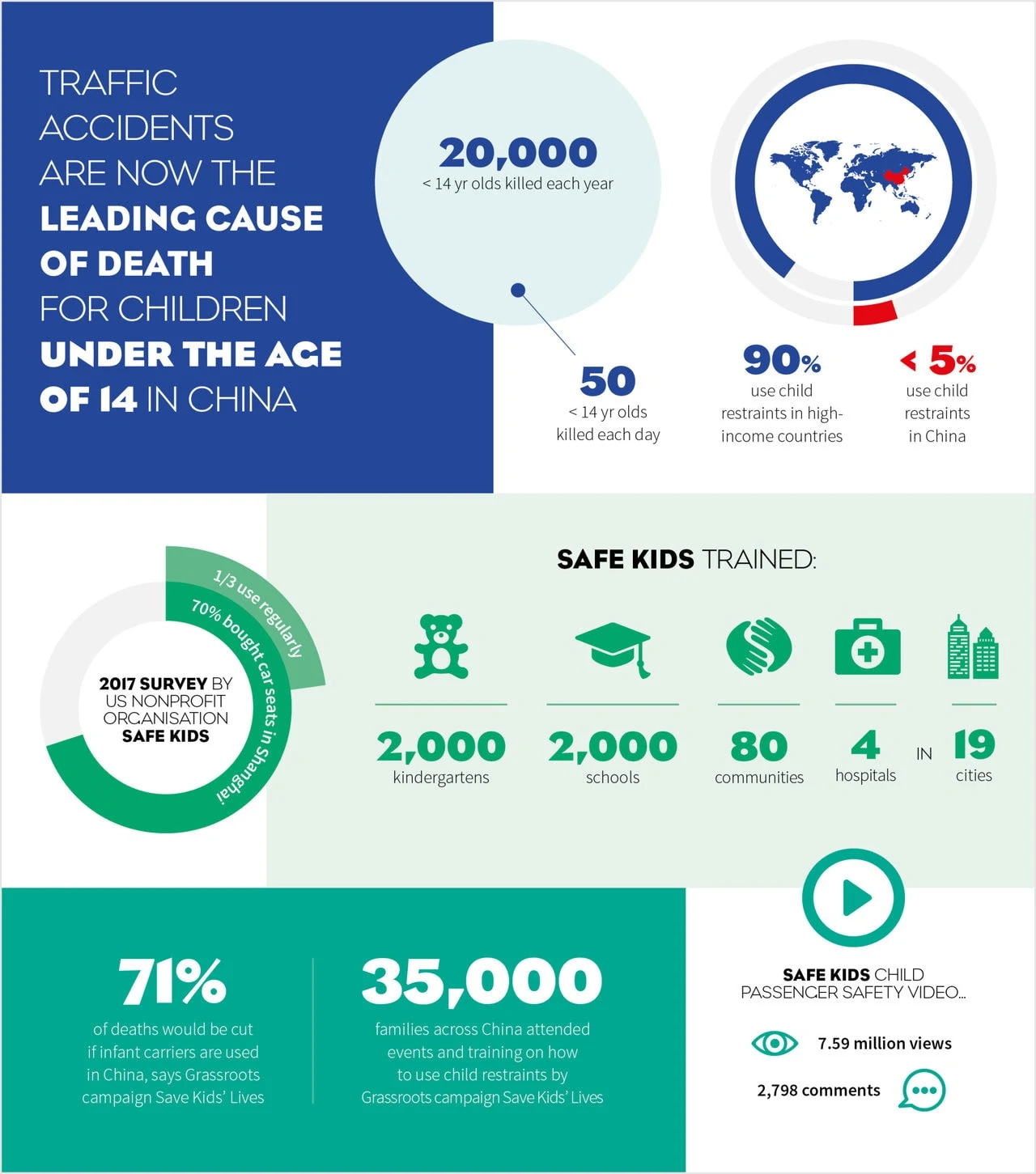Helen Roxburgh discovers that the introduction of child car seats could radically reduce child road deaths
Over the last decade, the number of cars in China have rocketed – and so too have the number of car accidents. According to official figures, traffic accidents are now the leading cause of death for children under the age of 14 in China; with nearly 20,000 killed each year on the roads. This shocking figure means around 50 children die every day in traffic accidents in China.
A large part of the staggeringly high number of deaths is down to a near non-existent use of child safety restraints. Children are commonly carried on the laps of adults – often not wearing their own seat belts – in over-crowded cars.
In high-income countries, the World Health Organisation says around 90 percent of parents regularly use child restraints; in China, experts say it is less than 5 percent. While awareness of car seats is growing, there is still a severe lack of education and a plethora of misconceptions.
“The awareness and the feeling of the need on the part of consumers is extremely low,” says James Feldkamp, CEO of consumer group Mingjian. “They need the intent to use a car seat, know how to choose the right car seat for their child’s weight and height, and they need to install them correctly.”
A 2017 survey by US nonprofit organisation Safe Kids found that of 70 percent of parents questioned in Shanghai had bought car seats, but only a third used them regularly, saying that the children don’t like them, installation is difficult, or that they are only being used for long journeys – although studies show most accidents happen close to home.
Of 70 percent of parents questioned in Shanghai had bought car seats, but only a third used them regularly
“I came and ran some training at a factory in China where they make these car seats,” says Lorrie Walker, training manager and technical advisor of the Safe Kids Buckle Up programme. “The people in the class were all engineers, designers, marketing people from the factory. The first thing we asked was how many people had children, and about three-quarters did. And of those, nobody was using a car seat because it was their belief that car seats are for other countries. And this was even at a factory which made them.”
Safe Kids says it provided training last year at over 2,000 kindergartens and 2,000 schools, in 80 communities and 4 hospitals in 19 cities. “It’s a very small drop in the bucket, but it’s a start,” says Walker, adding that social media can be an effective way to reach the new generation of Chinese parents, who often rely on peer advice and information from other parents more than the advice of previous generations. The group says a live streaming education child passenger safety video with a technician and celebrity mum attracted 7.59 million views with 2,798 comments, showing the reach of social media.
Globally around 90 percent of parents regularly use child restraints; in China, experts say it is less than 5 percent
Grassroots campaign Save Kids’ Lives, introduced by Mingjian and the Fresh Start Rotary Club China, is arguing the use of infant carriers in cars would cut deaths by as much as 71 percent in China. The campaigners have hosted events and training for how to use child restraints across China, attended by more than 35,000 families, as well as collaborations in maternity hospitals in Shanghai, Chongqing and Dalian. Now they are running a ‘train the trainers’ programme that allows them to reach more parents by training healthcare professionals who interact with parents from as early as pregnancy, in order to prepare them for the need for child car safety.

Only 5% of parents use car seats and they are too often regarded as toys
“In 2010 when we were starting, car seats not only were not mandatory at all in China, but the products were treated as toys,” says Feldkamp. “The only thing the product needed to pass statutory-wise was a toy standard; there was no crash testing at all. You had cheap and cheerful manufacturers from all over China making these things, and no standard for them – it was a hodgepodge, with different attachment points, different installations.”
Since then there have been legal improvements to bring requirements up to European standards, which has led to many companies exiting the market and non-compliant car seats being removed from the shelves.
Mingjian works with 12 automotive clubs and Which? in the UK to run independent testing for car seats, translating into Chinese videos produced by Which? about correct installation. It hosts a directory online that compares different car seats, using more stringent testing requirements than in China.
Car seat producer Apramo sells across a plethora of online giants in China like Taobao and jd.com, and says car seats with bright colours (particularly red) prove most popular with parents and children, compared with the typical black and grey which is most popular in Europe.
The use of infant carriers in cars would cut deaths by as much as 71 percent in China
President Johnny Wong says the two-child policy is expected to support growth in this market, alongside parents paying more attention to child road safety, and improving laws to regulate this area.
In 2013, Shanghai introduced a new amendment to the law making it illegal to let a child under the age of 12 ride in the front passenger seat, or for a child under 4 travel without a safety restraint. There are now nine cities with similar rules, but in many places this is barely enforced – Shenzhen recently became the first to introduce a fine for parents not complying.
Experts say the issue is very much on the government’s agenda, particularly as China is a signatory to the UN’s Global Goals and the Decade of Action for Road Safety, which aims to halve the number of road deaths globally by 2020.
“There’s a very ambitious new road safety law which this is tied to,” says Mingjian’s Feldkamp. “So the reason why it’s taking time is not because of a lack of will but because they are in the process of doing a very ambitious overhaul of the road safety law and trying to correct some things from past laws to make them clearer and to add on new components – including child restraints. China politically is on board and committed – but awareness and enforcement are critical.”



